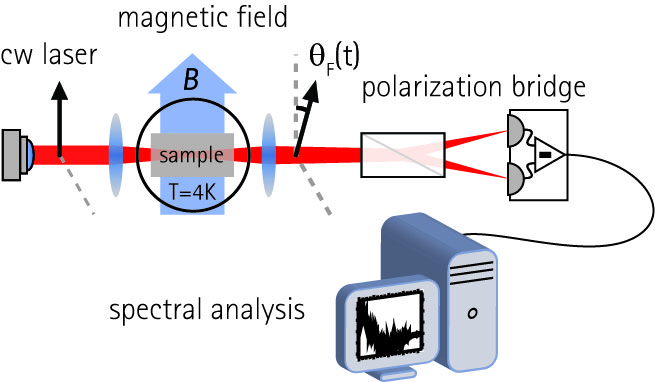-
Spin noise spectroscopy
Our group has succesfully employed spin noise spectroscopy (SNS) in semiconductor materials as a new sensitive tool to measure the spin-coherence time of electrons in n-GaAs nearly interaction free.
Noise spectroscopy is an elegant method to unravel properties of a system in thermal equili- brium, without exposing it to unnecessary excitations. Previously utilized techniques to study the spin-coherence of charge carriers, like photoluminescence or pump-probe techniques, had always to rely on the optical above band gap excitation of the material. Therefore a con- tribution, even though small, of non-equilibrium effects, carrier heating and the spin-depha- sing influence of holes can never be excluded. This is even more of importance if it comes to small size quantum systems. Spin noise spectroscopy in semiconductors empowers us to measure extreme long spin coherence times at low temperatures, which may have been masked in the past by effects like those mentioned above. The experiment can easily be extended to study spin-spin correlations in coupled quantum dots or phase transitions in semiconductors with magnetic impurities, without imposing a systematic influence on the underlying effects. The inherently low perturbation of this method makes it also very suitable to investigate single electron or hole spins in quantum dots or bound to impurities.
![]()
![]()
![]()
Typical spin noise spectrum The experimental principle (see graphic above) is based upon the measurement of the noise spectrum of the below band gap Faraday-rotation at low temperatures with high frequency spectrum analysis techniques.
A typical spin noise spectrum under external magnetic field (see graphic left) yields the spin lifetime τs, the g-factor and the number of fluctuating spins within the probe area.
-
Time-resolved photoluminescence
Circularly polarized laser pulses from a mode-locked Ti:sapphire laser are used to create an electron spin polarization in the conduction band of a semiconductor sample (e. g. GaAs) parallel to the excitation direction via the optical selection rules.
The sample is mounted in a cryostat with a superconducting magnet that can apply magnetic fields up to 9 T.
Photoluminescence (PL) is produced by the recombination of electron-hole pairs which then emit a photon that is either left or right circularly polarized according to the optical selection rules. In the case of spin polarized carriers the emission probability for left and right circular polarized light is different, i. e., the electron spin polarization manifests in the degree of optical polarization of the photoluminescence. Both circular polarized photoluminescence components are resolved by a Liquid Crystal Retarder (LCR) followed by a Linear Polarizer (LP) in consecutive measurements. A spectrometer disperses the photoluminescence to resolve the wavelength and a streak camera system records the time evolution of the photoluminescence providing a time resolution of up to 2 ps.![]()
![]()
![]()
Schematic depiction of a setup for time-resolved photoluminescence measurements ![]()
![]()
![]()
(a) Streak camera images of both polarized photoluminescence components of a measure- ment with applied magnetic field (the intensity is depicted in terms of colours and the white axes indicate the time and wavelength). The applied magnetic field causes the electron spin polarization to precess about the magnetic field leading to the oscillating intensity behaviour
of the polarization resolved photoluminescence (spin quantum beats).(b) Wavelength integrated temporal evolution of both photoluminescence components.
(c) Calculated degree of polarization of the photoluminescence. Fitting a damped oscillation
to the data yields the electron g-factor (Larmor frequency) and the electron spin lifetime (exponential decay).
Basics
Overview of some fundamental methods for the research of the group of Prof. Oestreich:











